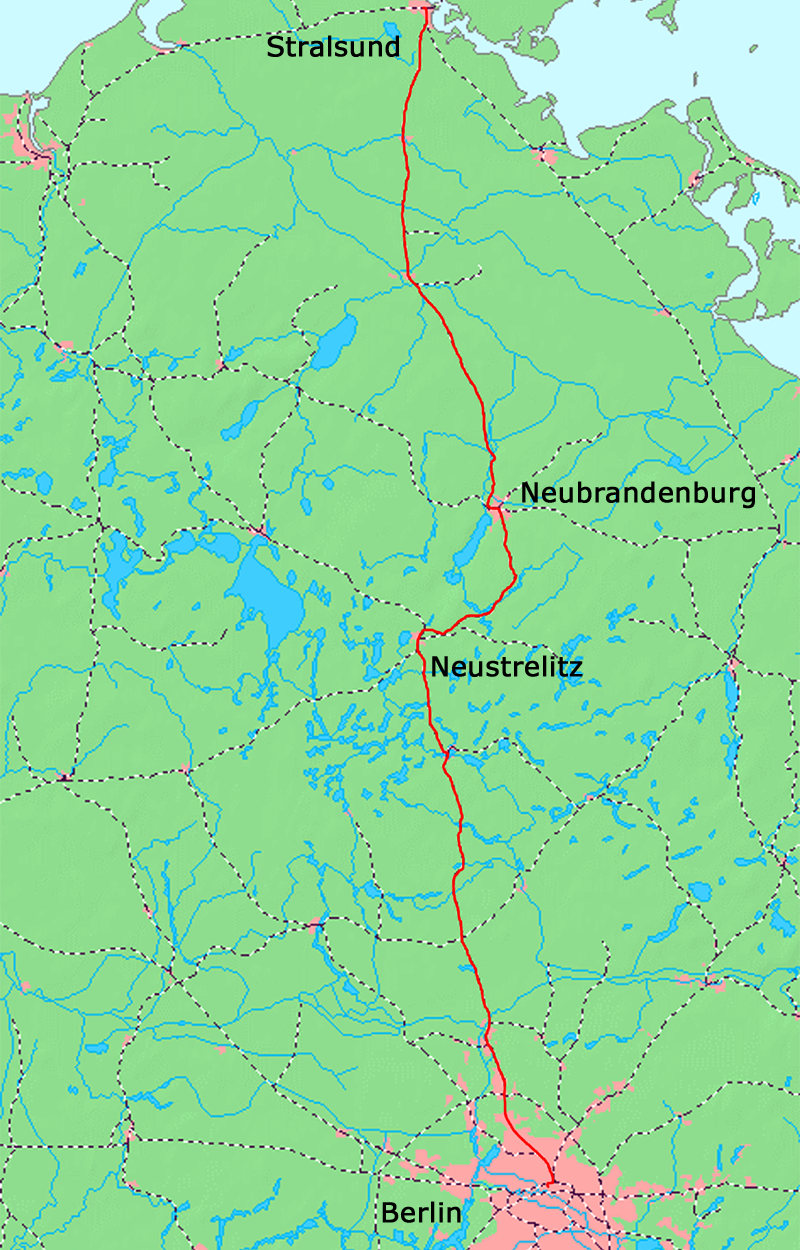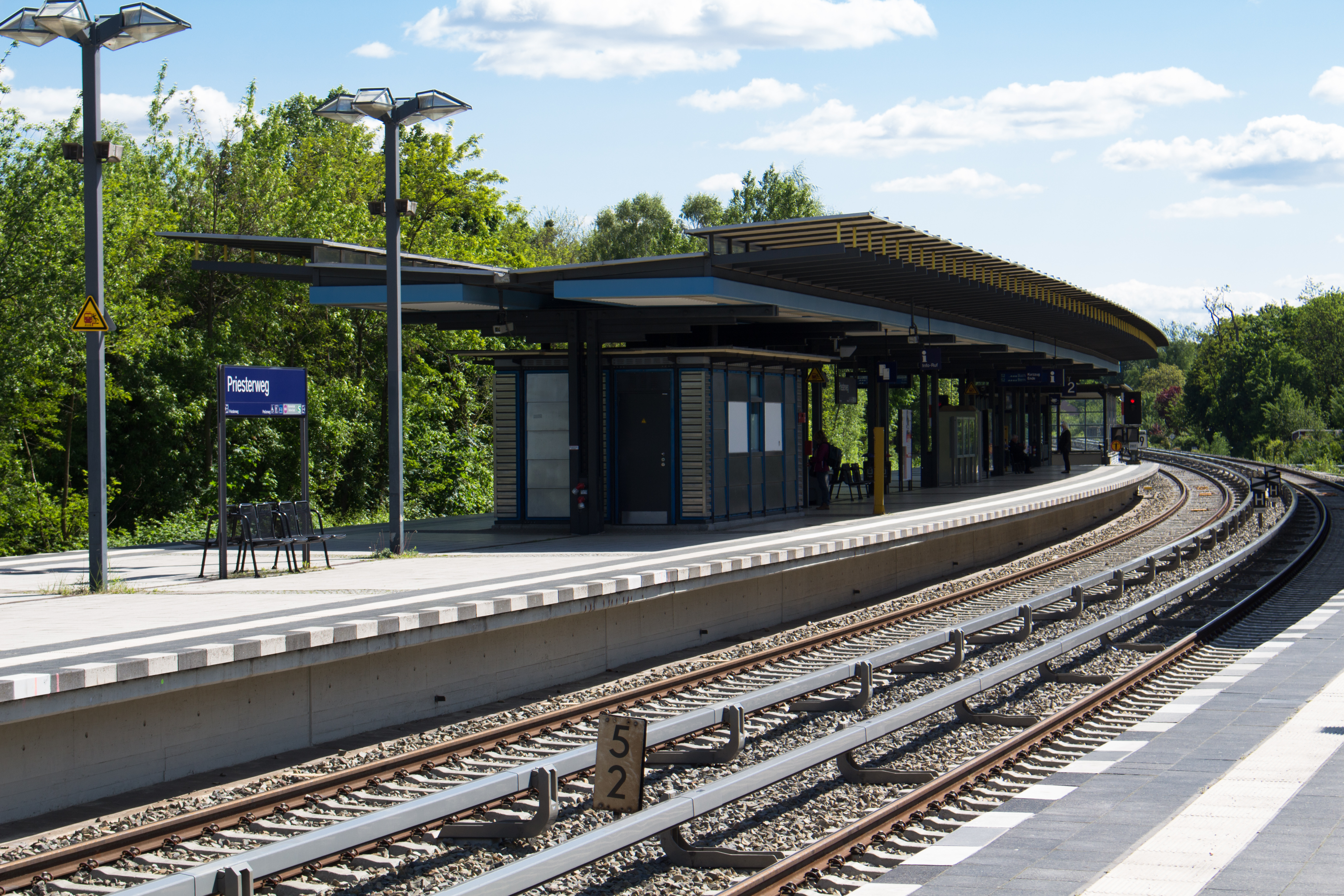|
S25 (Berlin)
S25 is a line on the Berlin S-Bahn. It operates from Teltow Stadt to Hennigsdorf over: *the Berlin-Lichterfelde Süd–Teltow Stadt railway, opened from Teltow Stadt to Lichterfelde Süd in February 2005, *the Anhalt Suburban Line, opened from Berlin Anhalter Bahnhof to Lichterfelde Ost on 1 December 1901 (the parallel Anhalt Railway was opened on 1 July 1841), electrified in June 1903 and extended to Lichterfelde Süd on 9 August 1943, *the Nord-Süd-Tunnel, opened on 28 May 1936 from Humboldthain to Unter den Linden and on 6 November 1939 to Anhalter Bahnhof and Priesterweg *a short section of the Berlin-Szczecin railway, opened on 1 August 1842 and electrified in 1924, *a short section of the Prussian Northern Railway, opened on 10 July 1877 and electrified in 1925 and *the Kremmen Railway The Kremmen Railway (german: Kremmener Bahn) is a line in northern Berlin and Brandenburg, Germany. It branches off the Prussian Northern Railway in the Berlin district of Reinick ... [...More Info...] [...Related Items...] OR: [Wikipedia] [Google] [Baidu] |
Berlin S-Bahn
The Berlin S-Bahn () is a rapid transit railway system in and around Berlin, the capital city of Germany. It has been in operation under this name since December 1930, having been previously called the special tariff area ''Berliner Stadt-, Ring- und Vorortbahnen'' (Berlin city, orbital, and suburban railways). It complements the Berlin U-Bahn and is the link to many outer-Berlin areas, such as Berlin Brandenburg Airport. As such, the Berlin S-Bahn blends elements of a commuter rail service and a rapid transit system. In its first decades of operation, the trains were steam-drawn; even after the electrification of large parts of the network, a number of lines remained under steam. Today, the term ''S-Bahn'' is used in Berlin only for those lines and trains with third-rail electrical power transmission and the special Berlin S-Bahn loading gauge. The third unique technical feature of the Berlin S-Bahn, the , is being phased out and replaced by a communications-based train con ... [...More Info...] [...Related Items...] OR: [Wikipedia] [Google] [Baidu] |
Berlin Anhalter Bahnhof
The Anhalter Bahnhof is a former railway terminus in Berlin, Germany, approximately southeast of Potsdamer Platz. Once one of Berlin's most important railway stations, it was severely damaged in World War II, and finally closed for traffic in 1952, when the GDR-owned '' Deutsche Reichsbahn'' rerouted all railway traffic between Berlin and places in the GDR avoiding the West Berlin area. The station's name lives on in the Berlin S-Bahn station of the same name, opened in October 1939 as part of the ''North-South S-Bahn link''. Construction Work to build the Anhalter Bahnhof began on 15 April 1839. As the Berlin terminus, of what become known as the Anhalt Railway, it opened on 1 July 1841 as far as Jüterbog (the inaugural train being hauled by the very first Borsig locomotive), and extended to Dessau, Köthen and beyond at later dates. It became known as the "Anhalt line" because it ran through the historical state of Anhalt, which in turn gave the new Berlin terminus ... [...More Info...] [...Related Items...] OR: [Wikipedia] [Google] [Baidu] |
Prussian Northern Railway
The Berlin Northern Railway (german: Berliner Nordbahn) is a 223-kilometre-long main line route, that runs from Berlin via Neustrelitz and Neubrandenburg to Stralsund on the Baltic Sea coast. Nowadays, long-distance and regional traffic on the Nordbahn is routed at Hohen Neuendorf onto the Berlin Outer Ring to the Karower Kreuz and on to Berlin Main Station or Berlin-Lichtenberg. History Construction of the line was preceded by decades of planning from 1843 until 1870 when the newly founded ''Berlin Northern Railway Company'' (German: ''Berliner Nord-Eisenbahn-Gesellschaft'') gained the concessions from the states of Prussia and Mecklenburg-Strelitz. For financial reasons, the company was dissolved on 15 December 1875. The Prussian government acquired the unfinished railway and handed over further construction of it to the Lower Silesian-Markish Railway (''Niederschlesisch-Märkische Eisenbahn''). The opening took place in three stages: *10 July 1877: Berlin–Oranienburg–Ne ... [...More Info...] [...Related Items...] OR: [Wikipedia] [Google] [Baidu] |
Priesterweg Railway Station
Priesterweg station is on the Anhalt Suburban Line in the district of Schöneberg in the Berlin borough of Tempelhof-Schöneberg. It is served by Berlin S-Bahn lines S2, S25, and S26. Location The station is located in the district of Schöneberg in Tempelhof-Schöneberg. The Berlin city center lies 8 km to the northeast. It fronts onto the streets of Priesterweg and Prellerweg to the west. Located east of the station on former rail yards is the ''Natur-Park Schöneberger Südgelände'' (South Grounds Nature Park). Southwest is the ''Insulaner'' (literally “islanders”, which was derived from the name of a cabaret program broadcast on Rundfunk im amerikanischen Sektor during the Berlin Blockade), a hill formed of rubble created by Second World War bombing raids, which the Wilhelm-Foerster Observatory is located on. Südkreuz station is located about 1.8 kilometres to the north, Attilastraße station is about 1.3 km to the south and Südende station is about 1.4&n ... [...More Info...] [...Related Items...] OR: [Wikipedia] [Google] [Baidu] |
Berlin Brandenburger Tor Station
Berlin Brandenburger Tor (in German ''Bahnhof Berlin Brandenburger Tor'') – formerly Berlin Unter den Linden (1936-2009) – is an underground railway station in the central Mitte district of Berlin, Germany, located on the Unter den Linden boulevard near Hotel Adlon, Pariser Platz and Brandenburg Gate. It is served by the Berlin S-Bahn and U-Bahn, as well as local bus lines. Overview The station opened on 27 July 1936 in the course of the building of the ''Nord-Süd Bahn'' tunnel. Train service discontinued on 21 April 1945 and could not be resumed until 2 December 1946 as the tunnel was flooded. The station was again closed with the construction of the Berlin Wall on 13 August 1961 and for decades became one of Berlin's ghost stations, as while both terminals of the ''Nord-Süd'' railway line were located in West Berlin, the station itself was located in the East. Unter den Linden later reopened on 1 September 1990, following the German reunification. On completion of the ... [...More Info...] [...Related Items...] OR: [Wikipedia] [Google] [Baidu] |
Berlin Humboldthain Station
Berlin Humboldthain (in German Bahnhof Berlin Humboldthain) is a railway station in the city of Berlin, Germany. It is served by the Berlin S-Bahn The Berlin S-Bahn () is a rapid transit railway system in and around Berlin, the capital city of Germany. It has been in operation under this name since December 1930, having been previously called the special tariff area ''Berliner Stadt-, Ri ... lines ,, and . It is also served by local bus route 247. History The S-Bahn station was opened on 21 January 1935, construction having started on 8 January 1934. Services The station is served by the following services: * Berlin S-Bahn services ''Oranienburg – Wittenau – Gesundbrunnen – Friedrichstraße – Potsdamer Platz – Schöneberg – Steglitz – Wannsee'' * Berlin S-Bahn services ''Bernau – Karow – Pankow – Gesundbrunnen – Friedrichstraße – Potsdamer Platz – Sudkreuz – Blankenfelde'' * Berlin S-Bahn services ''Hennigsdorf – Tegel – Gesundbrunnen ... [...More Info...] [...Related Items...] OR: [Wikipedia] [Google] [Baidu] |
Berlin Nord-Süd-Tunnel
Berlin ( , ) is the capital and largest city of Germany by both area and population. Its 3.7 million inhabitants make it the European Union's most populous city, according to population within city limits. One of Germany's sixteen constituent states, Berlin is surrounded by the State of Brandenburg and contiguous with Potsdam, Brandenburg's capital. Berlin's urban area, which has a population of around 4.5 million, is the second most populous urban area in Germany after the Ruhr. The Berlin-Brandenburg capital region has around 6.2 million inhabitants and is Germany's third-largest metropolitan region after the Rhine-Ruhr and Rhine-Main regions. Berlin straddles the banks of the Spree, which flows into the Havel (a tributary of the Elbe) in the western borough of Spandau. Among the city's main topographical features are the many lakes in the western and southeastern boroughs formed by the Spree, Havel and Dahme, the largest of which is Lake Müggelsee. Due to its locatio ... [...More Info...] [...Related Items...] OR: [Wikipedia] [Google] [Baidu] |
Anhalt Railway
Saxony-Anhalt (german: Sachsen-Anhalt ; nds, Sassen-Anholt) is a state of Germany, bordering the states of Brandenburg, Saxony, Thuringia and Lower Saxony. It covers an area of and has a population of 2.18 million inhabitants, making it the 8th-largest state in Germany by area and the 11th-largest by population. Its capital is Magdeburg and its largest city is Halle (Saale). The state of Saxony-Anhalt was formed in July 1945 after World War II, when the Soviet army administration in Allied-occupied Germany formed it from the former Prussian Province of Saxony and the Free State of Anhalt. Saxony-Anhalt became part of the German Democratic Republic in 1949, but was dissolved in 1952 during administrative reforms and its territory divided into the districts of Halle and Magdeburg. Following German reunification the state of Saxony-Anhalt was re-established in 1990 and became one of the new states of the Federal Republic of Germany. Saxony-Anhalt is renowned for its r ... [...More Info...] [...Related Items...] OR: [Wikipedia] [Google] [Baidu] |
Anhalt Suburban Line
The Anhalt suburban line (german: Anhalter Vorortbahn) is a suburban railway in Berlin and Brandenburg. It originally ran from Potsdamer Ringbahnhof in Berlin over the Berlin–Halle railway (also called the ''Anhalter Bahn'' or Anhalt Railway). With the opening of the Berlin Nord-Süd Tunnel in 1939, this service was abandoned. Subsequently, the electric services ran to the south parallel with the long-distance tracks of the Anhalt Railway. Its terminus was at Berlin-Lichterfelde Ost until the 1940s. In 1943, it was extended to Lichterfelde Süd for electric trains and to Ludwigsfelde for steam trains. The construction of the Berlin Wall in 1961 stopped services at the outskirts of Berlin. In 2005, a new Berlin-Lichterfelde Süd–Teltow Stadt S-Bahn line was opened. History The population of many towns and villages around Berlin grew significantly in the late 19th century. Lichterfelde (incorporated into Groß-Lichterfelde, meaning Greater Lichterfelde, from 1884) grew into ... [...More Info...] [...Related Items...] OR: [Wikipedia] [Google] [Baidu] |
Berlin
Berlin ( , ) is the capital and List of cities in Germany by population, largest city of Germany by both area and population. Its 3.7 million inhabitants make it the European Union's List of cities in the European Union by population within city limits, most populous city, according to population within city limits. One of Germany's States of Germany, sixteen constituent states, Berlin is surrounded by the Brandenburg, State of Brandenburg and contiguous with Potsdam, Brandenburg's capital. Berlin's urban area, which has a population of around 4.5 million, is the second most populous urban area in Germany after the Ruhr. The Berlin/Brandenburg Metropolitan Region, Berlin-Brandenburg capital region has around 6.2 million inhabitants and is Metropolitan regions in Germany, Germany's third-largest metropolitan region after the Rhine-Ruhr and Frankfurt Rhine-Main, Rhine-Main regions. Berlin straddles the banks of the Spree (river), Spree, which flows into the Havel (a tributary of ... [...More Info...] [...Related Items...] OR: [Wikipedia] [Google] [Baidu] |
Berlin-Lichterfelde Süd Station
Lichterfelde () is a locality in the borough of Steglitz-Zehlendorf in Berlin, Germany. Until 2001 it was part of the former borough of Steglitz, along with Steglitz and Lankwitz. Lichterfelde is home to institutions like the Berlin Botanical Garden and Museum, the German Federal Intelligence Service (BND), the German Federal Archives and the Charité university hospital's ''Benjamin Franklin Campus''. Many embassies and landmark-protected buildings are located in the affluent mansion settlement in Lichterfelde West. History The Prussian village ' was founded in the 13th century by Flemish settlers. It witnessed considerable growth in the 19th century when the two "villa colonies" of and were founded: two elegant settlements for wealthy Berliners consisting completely of villas or mansions. The settlements and the historical villages of ' and ' were united in 1880 under the name ' (Greater Lichterfelde). Lichterfelde was chosen as the seat of the Prussian Main Military a ... [...More Info...] [...Related Items...] OR: [Wikipedia] [Google] [Baidu] |








